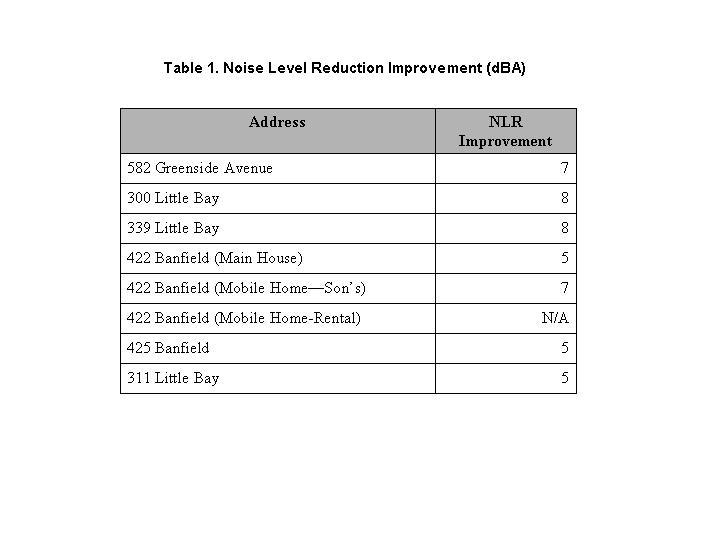
Introduction
Noise Level Reduction (NLR) tests were performed by David Coate Consulting (DCC) before and after the installation of sound insulation treatments for the Group 2 homes in the Pease Tradeport Residential Sound Insulation Program (RSIP).
The sound tests determine the NLR of the composite house construction, that is, the capacity of all the construction elements (walls, roof/ceiling, windows, doors, and other openings) taken as a whole to attenuate exterior sound in each room that was tested. However, the data is typically presented to show the effect of a particular window or door in a specific room because those typically control the NLR of the room. The NLR measurements are presented in octave bands (by frequency) and by overall A-weighted decibels (dBA) outside to inside. A weighting simulates the frequency response of the human hearing mechanism.
Results
The RSIP is designed to meet the goals stated in the FAA’s “Guidelines for the Sound Insulation of Residences Exposed to Aircraft Operations” (DOT/FAA/PP-92-5, October, 1992). This document indicates that homes within the 65 Day Night Average Noise Level (DNL) contours eligible for treatments would require an interior noise level of 45 DNL or lower and a 5 dB improvement after treatments were installed. The 5 dB improvement is required so that there is a noticeable reduction in aircraft noise.
Sound insulation strategies attempt to improve the sound isolation characteristics of the building envelope by addressing the weakest paths into the building. The weakest paths usually are windows and doors. Window and door treatments usually involve adding mass and/or a deeper airspace.
There are a number of homes in Group 2 which are historical or of non-standard construction which in some cases required non-standard treatment approaches. For example, historical homes may have an aesthetic requirement that windows not look modern or industrial, and blend into the historical look of the building.
On average, the test results were as follows:
• For initial conditions, the average NLR was 32 dBA.
• For final conditions, the average NLR was improved to 38 dBA.
• For final conditions, the improvement in NLR was on average 6 dBA. A ten decibel improvement would be considered a halving of the perceived loudness. In all cases, the average NLR improvement for an entire dwelling unit was consistently greater or equal to 5 dBA. An overall average NLR improvement value for one mobile home was not possible to obtain because the initial condition consisted of windows, while the final condition consisted of a glass sliding door. This change was made at the homeowner’s request. In its final condition, this particular building has excellent sound reduction characteristics, and is considered a successful part of the program.
• All homes meet the FAA 45 DNL interior noise goal.
The NLR testing actually understates the amount of improvement in buildings receiving air conditioning. The EPA has found that on average, the improvement in NLR afforded by allowing windows to be closed (with air conditioning) is 10 dBA. (reference- Information On Levels of Environmental Noise Requisite to Protect Public Health and Welfare With an Adequate Margin of Safety" (EPA, March 1974)) This improvement does not include the additional improvement provided by window and door sound insulation treatments.
Octave Band Analysis
The single A-weighted decibel value is a universally accepted method for reporting field sound tests. However, the overall A-weighted NLR is affected by the frequency spectrum of the source of sound. In general, the greater the amount of low frequency content, the lower the overall A-weighted NLR.
Our octave band analysis revealed the following:
• Improvements due to program treatments occur at 500 Hz and above.
• For initial conditions, the dBA NLR value is controlled by the 500 Hz octave band.
• For final conditions, the dBA NLR value is controlled by the 250 Hz octave band. Essentially, sound levels at frequencies higher than 250 Hz are reduced as a result of the deeper airspace provided by the treatments.
Description of the Acoustical Testing Procedure
The test procedures were conducted with calibrated equipment in compliance with FAA standards and in accordance with ASTM Designation E 966 “Standard Guide for Field Measurement of Airborne Sound Insulation Building Facades and Façade Elements.” This method uses a loudspeaker system and pink noise generator to generate broad band noise (essentially a flat frequency response of random noise) which is sufficiently loud enough to be easily measured indoors with windows and doors closed. The difference between measured noise levels indoors and outdoors is the NLR.
Typically three to five rooms (if available) in a house were selected for testing in order to provide measurement results for representative rooms, windows, and doors. Octave band data and overall A-weighted NLR values were generated for both initial and final conditions for each room tested. Finally, the measured data were adjusted using a flat frequency response to compensate for the non-linear frequency response of the testing system.
NLR measurements can vary substantially from one another due to the area of windows on the façade being tested, the amount of acoustical absorption in the room being tested, and other factors including the condition and the tightness of the seal of the window. In addition, anomalous low-frequency data can overstate the NLR performance, and in those cases, several measurements should be performed within a specific room in order to average out low-frequency anomalies in the test data. However, due to the limited testing time available for each house, only one measurement was done in each room tested. For this reason as well as other reasons for variation in specific window and door performance results, an average NLR improvement value is typically calculated for each house.
Group 2 Noise Level Reduction Improvement
Table 1 shows the overall average NRL improvement for each house in Group 2.
